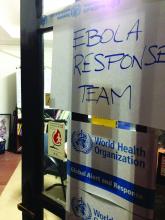The struggle to defeat Ebola virus disease continues globally, although it may not always make the headlines. To catch up on what you may have missed, here are some notable news items and journal articles published over the past few weeks that are worth a second look.
A study in Cell found that specific amino acid substitutions in the Ebola virus glycoprotein have increased tropism for human cells, while reducing tropism for bat cells, and such increased infectivity may have contributed to the wide geographic distribution of some viral lineages.
Vaccinations with BCG for tuberculosis in those under age 5 in West Africa were affected adversely by the 2014-2015 Ebola virus disease outbreak, according to a study in the International Journal of Infectious Diseases.A recent case study of a West African Ebola survivor demonstrated the persistence of T-cell activation well beyond viral clearance and detected Ebola-specific T cells, providing insights into lymphocyte specificity during the reconvalescent phase of Ebola virus disease.
The Ebola virus glycoprotein mutant GP-A82V arose early and dominated the 2013-2016 West African epidemic, according to a recent study, and it was weakly associated with increased mortality during the epidemic.
A modeling study on a region of Sierra Leone provided numerical estimates for the effectiveness of ring vaccination to control future Ebola virus outbreaks. Investigators showed that outbreaks with moderate transmission potential can be successfully contained, and more extensive vaccination and reinforcement of the health care system would increase the likelihood of containment even if the virus were more transmissible than in the past.
An RT-PCR (reverse transcriptase polymerase chain reaction) diagnostic assay using a glycoprotein target is more sensitive for the detection of Ebola virus in clinical samples than is an RT-PCR using a nucleoprotein target, according to a study in Diagnostic Microbiology & Infectious Disease.
Convalescent whole blood therapy is promising for treating Ebola virus disease in resource-poor settings, especially in the early phases of outbreaks when resource mobilization is done, according to a study in the Journal of Infection.
Rapid chart reviews at Ebola virus disease survivor clinics should be repeated regularly to assess the extent of illness and prioritize service delivery, according to a study in Sierra Leone.
The 2014-2016 outbreak of Ebola virus disease in West Africa harmed the tourism industry in Kenya, according to a study by the University of Nairobi.
Researchers have developed Microreact, a free, real-time epidemic visualization and tracking platform that has been used to monitor outbreaks of Ebola, Zika, and antibiotic-resistant microbes, according to a report in Microbial Genomics.
A study in the Journal of Virology found that Ebola virus variants with improved fitness emerged early during the West African Ebola virus outbreak, impacting virus transmissibility and pathogenicity.
A literature review published in BMC Infectious Diseases found the pooled case fatality rate and seroprevalence for Ebola and Marburg viruses to be lower than usually reported, with species differences despite high heterogeneity between studies.
A study of the scope and scale of the 2014-2015 Ebola virus outbreaks in West Africa found broad socioeconomic impacts, including reduced community cohesion, education loss, reduced child protection, widespread job losses, and food insecurity.
On Twitter @richpizzi


